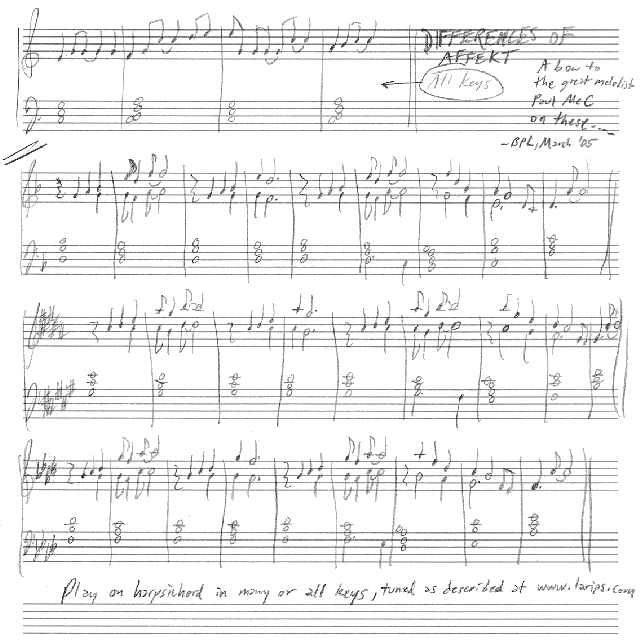 LaripS.com, © Bradley Lehman, 2005-22, all rights reserved. All musical/historical analysis here on the LaripS.com web site is the personal opinion of the author, as a researcher of historical temperaments and a performer of Bach's music.
Affekt (clarity of emotional content) is emergent behavior from the rules of music: melody, harmony, rhythm, counterpoint, tone, articulation, phrasing, accent, .... This tuning is an especially good catalyst for that musical process, making it easy for Affekt to emerge. Affekt TestsAffekt (clarity of emotional content) is emergent behavior from the rules of music: melody, harmony, rhythm, counterpoint, tone, articulation, phrasing, accent, .... This tuning is an especially good catalyst for that musical process, making it easy for Affekt to emerge.Here is a pair of quick test pieces that I scrawled for a university lecture about this temperament. They are to be played in many keys, to hear the differences of expression that are built into the temperament. How do they make the listener feel due to the melodic and harmonic tensions?

(Click to super-size that, for printing...) And here's another one: a harmonization of "Twinkle, Twinkle, Little Star" given in F, D, B, and Ab major. This is especially useful to play in side-by-side comparisons of the Bach temperament, meantone, equal, and any others. This piece tests the behavior of diatonic harmony, including some passing tones, suspensions, sevenths, ninths, and one accidental. Remarkably, in 1/6 comma meantone the single D# of the D major version (tuned as an Eb) works better than it seems it "should" on paper (because it is played as a pure tritone in its context, with wide-open spacing of the other voices)...but the B major version as a whole is "right out", and the Ab version is worse. (Click to open in a separate window, for printing.... A larger and less smudgy scan is also available by e-mail request.) Here's a handy roster of all the keys, Johann David Heinichen's diagram from 1728. Note: in German, "B" is B-flat and "H" is B.

More about Affekt at Wikipedia....
A suggested list of Bach repertoire to test Affekt is here.
Testing the results with the music(These paragraphs are recycled from the 20 September 2004 version of my manuscript, before Oxford's copy-editing for publication trimmed them out of the article. They are added to larips.com on 5-Dec-05, slightly edited for web site context.)Bach's explicit tuning method solves dozens of musical and historical problems in a single pen-stroke. That set of premises is so complex that no single specific solution seemed knowable. To confirm this, first tune a harpsichord and an organ as described here. Play representative repertoire (including improvisation of continuo) as described in The Bach Reader, The New Bach Reader, and Bach-Dokumente: with regard to Bach's performances, teaching, intonation, tuning, organ examination, and musical taste. Also crucial in the area of taste is Rita Steblin's book A History of Key Characteristics in the Eighteenth and Nineteenth Centuries (with some origins in the seventeenth as well): to understand what musicians considered normal and beautiful as to the balanced organization of keys. Then retune the instruments to any of the methods shown here, or anywhere else: play through the same examples to hear the various types of harshness and obtrusions that occur in Bach's music (especially in the flat keys) whenever his temperament is not used. It is not sufficient to glance at key signatures to see how well the pieces "should" work in a particular tuning, but the entire piece must be played. Listen especially for the intervals Db-F, Ab-C, F#-A#, and B-D# in all their contexts, and for the way the individual sharps and flats (all the way out to E#-B#-Fx-Cx, and to Cb-Fb-Bbb-Ebb) behave in diatonic contexts: differently from one another, and differently from naturals. Similarly, listen to the behaviour of naturals as exceptions within the sharp or flat keys. Through such a complex listening test, the better organization within Bach's system becomes clear. Notice also the overall effect of the music, in the way it has clarity of Affekt and the way it continuously refreshes the listeners' attention. (Equal temperament has suited all the previous conditions, until that point!) Quantz expressed this issue in his advice to those who would be music critics: "They will be on the safest side if, in great assemblies where a piece is sung or played, they pay attention to the mien and gestures of the listeners (these assemblies must be the kind where the main object is to listen to music, however, and in which the music is not regarded as a purely incidental matter, assemblies where connoisseurs as well as people who are not conversant with music are among the listeners). They should try to perceive whether the attention of only a few or that of the majority of those present is aroused; whether the listeners make their pleasure or displeasure known to one another; whether some draw near to the performers of the music, or stray away; whether the listeners are silent or talk loudly; whether they mark the time with their heads; whether they are curious as to the author of the composition; and whether, when the piece ends, those present indicate a desire to hear it again. Finally, such listeners must also inquire into their own feelings a little, and seek to determine whether the music they have heard has moved them, even if they are not able to tell the reason for it." [Johann Joachim Quantz, paragraph 52 of chapter 18, "How a Musician and Musical Composition Are to Be Judged", in Versuch einer Anweisung die Flöte traversiere zu spielen, 1752; English translation by Edward Reilly as On Playing the Flute, 2nd edition, 1985. The entire chapter is an invaluable collection of insights about musical quality and the nature of fair criticism.] To determine a temperament's appropriateness in repertoire it is not sufficient merely to avoid causing displeasure; rather, the more difficult and rewarding task for a temperament (and for a performer's technique!) is to bring out positive features of the music with utmost clarity, without drawing attention to itself. For a survey, one should play through at least the Four Duetti (BWV 802-5), the Fantasia BWV 922, the Toccata BWV 910, the Ricercars of the Musical Offering (BWV 1079), and O Mensch, bewein dein Sünde groß (BWV 622), in addition to the WTC. Does O Mensch cause gooseflesh (in a good way!), or cringes? Does the BWV 922 Fantasia seem intensely sensual, perhaps even violent, or merely dull and aimless? As another exercise to experience the progression of character, play through all six of the French Suites. The first suite uses no "wrong" enharmonics at all, and therefore gives us old-fashioned meantone character everywhere. Suite 2 explores the major thirds of Ab-C and Db-F, intervals that do not work well in many temperaments except this one. Suite 3 explores the new notes of A#, E#, and D#. Suite 4 explores Gb and Db, and the mellow properties of E-flat major. Suite 5 gives us a breather: all pleasant and light, except for some momentary chromaticism. Then the last suite uses the extraordinary "new-fangled" E major, with its special sweetness. And then try the additional examples in Bach's repertoire. Only the particular harmonic/melodic balance of Bach's own temperament satisfies all the extant documentation, allows all his music to be played without retuning, and reveals the expressively dynamic dimension of modulation.
 |
v Introduction v Articles v FAQ > Practice - Hear samples - Tune it:Begin - Tune it:Interm - Tune it:Expert - Vocal music - Test pieces * Affekt tests - Organ 41 - Adventures v Theory v History v Etc v Recordings |



